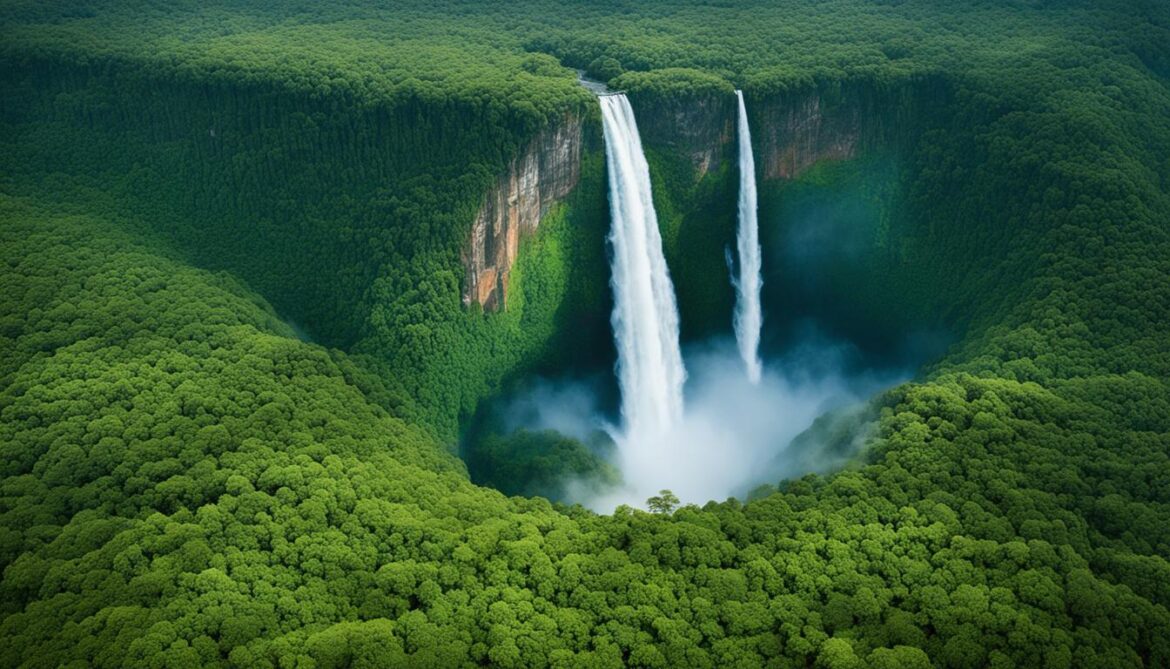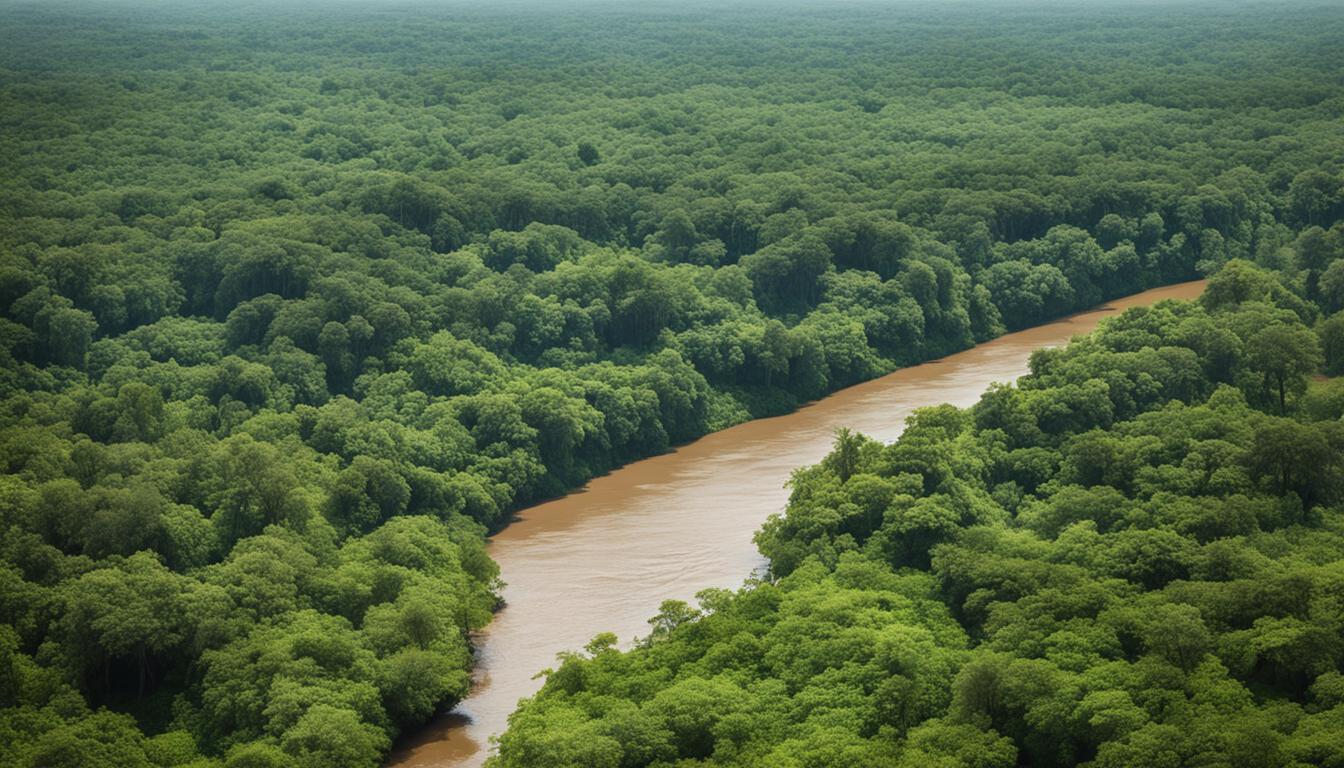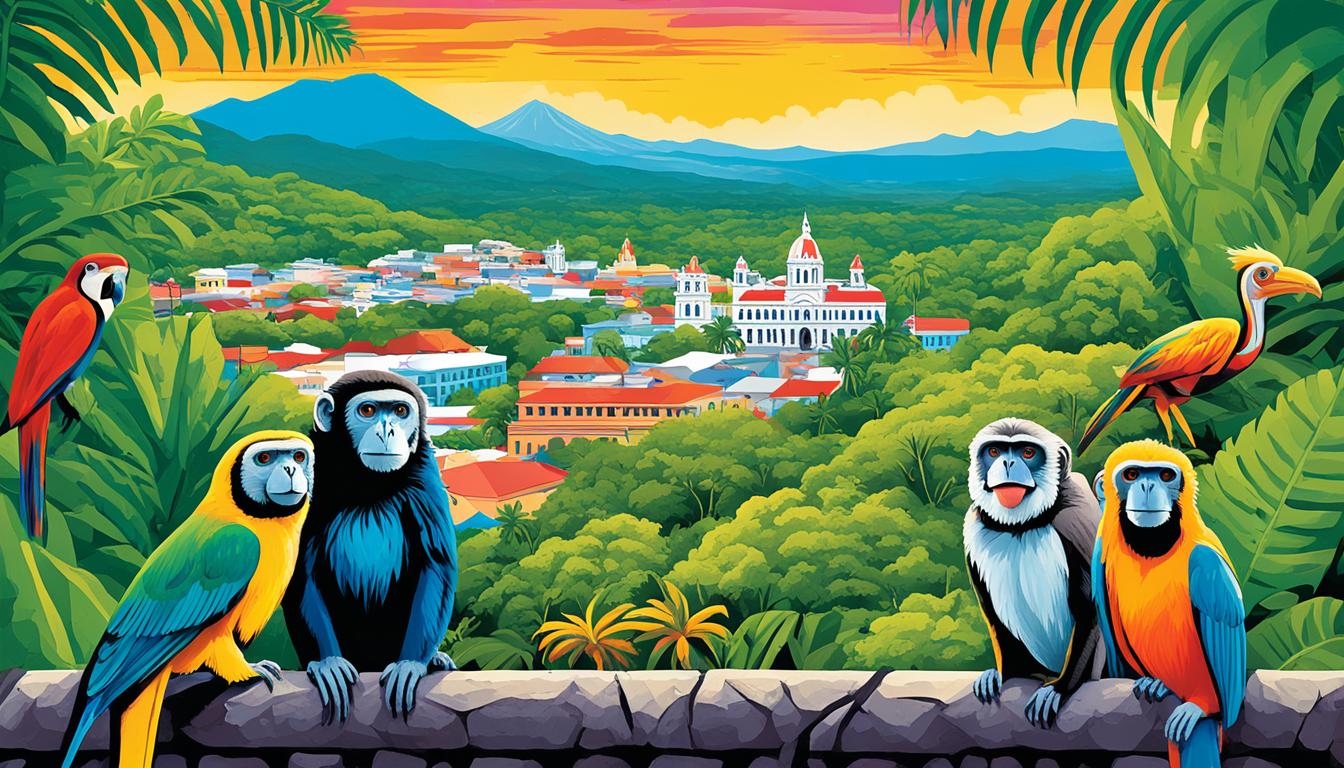Guyana Sacred Natural Sites and Biodiversity
Did you know that Guyana, located in northeastern South America, is home to one of the world’s largest intact rainforests, covering a staggering 80% of the country? This small nation is a biodiversity hotspot, teeming with iconic Amazonian species and breathtaking natural landscapes. But what sets Guyana apart is its unique approach to conservation, rooted in the cultural significance of sacred natural sites and the wisdom of indigenous communities.
Key Takeaways:
- Guyana boasts pristine rainforests, covering 80% of the country, making it a hotspot for biodiversity. (Guyana Rainforests, Biodiversity Hotspots)
- Sacred natural sites hold immense cultural and spiritual value for indigenous communities and serve as reservoirs of biodiversity. (Importance of Sacred Natural Sites)
- Conservation efforts in Guyana integrate indigenous and non-indigenous knowledge, ensuring a sustainable future for both biodiversity and local communities. (Conservation and Eco-tourism in Guyana, The Role of Indigenous and Non-Indigenous Knowledge in Conservation)
- Guyana’s commitment to eco-tourism provides economic opportunities for local communities while raising awareness about the importance of biodiversity conservation. (Conservation and Eco-tourism in Guyana)
- Preserving traditional knowledge and practices is crucial for the sustainable future of Guyana’s sacred natural sites and the communities that depend on them. (Challenges to Conservation in Guyana)
The Importance of Sacred Natural Sites in Guyana
In Guyana, the conservation of sacred natural sites holds great significance for both biodiversity and cultural value. These sites, considered the oldest form of habitat protection in human history, are increasingly recognized as vital reservoirs of biodiversity. The indigenous communities, particularly the Makushi people, deeply understand and appreciate the importance of these sites and actively work towards their conservation.
At the heart of the conservation efforts are the traditional ecological knowledge and practices associated with sacred natural sites. This wisdom, passed down through generations, provides invaluable guidance in developing effective conservation strategies. The integration of indigenous and non-indigenous knowledge systems is crucial to ensure a sustainable future for Guyana’s biodiversity and the social integrity of indigenous communities.
The cultural value of sacred natural sites cannot be overstated. These sites hold profound spiritual and historical significance for indigenous communities, serving as living connections to their ancestors and diverse cultural heritage. By protecting these sites, Guyana embraces its rich cultural diversity and preserves the collective memory of its indigenous peoples.
“Sacred natural sites are not just physical spaces; they encompass stories, rituals, and a deep understanding of the interconnectedness between humans and nature.” – Indigenous community representative
Conservation efforts in Guyana strive to ensure the holistic well-being of both the environment and its people. By recognizing the importance of sacred natural sites, the country takes a proactive approach towards biodiversity conservation, sustainable development, and the preservation of indigenous cultural practices. These efforts also contribute to the emerging field of eco-tourism, allowing visitors to experience the spiritual and ecological richness of sacred sites while supporting local communities economically.
To summarise, the importance of sacred natural sites in Guyana cannot be overstated. They are not just physical locations; they are living embodiments of history, culture, and biodiversity. By protecting these sites and integrating traditional ecological knowledge, Guyana takes significant steps towards a sustainable and inclusive future, where the precious natural heritage of the country is preserved for generations to come.
Guyana’s Rainforests and Biodiversity Hotspots
Guyana is home to vast rainforests that cover an impressive 80% of the country, making it a haven for nature enthusiasts and biodiversity lovers. These rainforests are part of the Guiana Shield, a remarkable natural habitat and one of the world’s last four Frontier Forests.
Within these rainforests, a diverse array of plant and animal species thrives, creating biodiversity hotspots of global significance. Among the iconic Amazonian species that call Guyana’s rainforests home are jaguars, harpy eagles, giant anteaters, and giant river otters.
The rainforests of Guyana play a vital role in maintaining the overall ecological health of the region. They serve as crucial habitats for countless species and contribute to the stability and balance of ecosystems.
The Guiana Shield, encompassing Guyana’s rainforests, is recognized globally for its pristine condition and its ability to sustain diverse ecosystems and rare species. The Shield’s untouched landscapes and rich biodiversity make it a focal point of conservation efforts, aiming to preserve its unparalleled natural heritage for future generations.
The Importance of Biodiversity Hotspots
Biodiversity hotspots like Guyana’s rainforests play a crucial role in the conservation of global biodiversity. These regions are characterized by exceptionally high levels of species richness and endemism, making them a priority for conservation efforts. By protecting and preserving biodiversity hotspots, we can safeguard unique species and ecosystems that contribute to the overall health of our planet.
Conservation initiatives in Guyana aim to ensure the long-term protection of these remarkable rainforests and their invaluable biodiversity. By promoting sustainable practices and engaging local communities, these efforts strive to strike a balance between conservation and the well-being of the people who call these rainforests their home.
Preserving the Guiana Shield’s Frontier Forests
The Guiana Shield’s Frontier Forests, including Guyana’s rainforests, are a testament to the resilience and importance of untouched wilderness. These forests are truly unique and continue to captivate scientists and nature enthusiasts alike with their untouched landscapes and rare species.
Efforts to protect the Frontier Forests of the Guiana Shield extend beyond Guyana’s borders, as international collaborations recognize the global significance and need for their preservation. By preserving these Frontier Forests, we ensure that their remarkable beauty, biodiversity, and ecological services continue to thrive for generations to come.
The Cultural and Ethnic Diversity of Guyana
Guyana is a culturally diverse country with a rich tapestry of ethnic diversity. It is home to indigenous peoples such as the Arawak, Wai Wai, Carib, Akawaio, Arecuna, Patamona, Wapishana, Makushi, and Warao. Among them, the Makushi stand out as the dominant group in the North Rupununi area, where they have a long-standing history of residing in the forests and savannas.
This cultural diversity is one of the defining features of Guyana, contributing to the country’s vibrancy and cultural heritage. The indigenous communities, including the Makushi, play a crucial role in the conservation efforts and sustainable future of Guyana’s sacred natural sites.
“The cultural diversity of Guyana is a testament to the harmonious coexistence of different ethnic groups, each with their own traditions, languages, and customs. This diversity acts as a powerful reminder of the importance of cultural preservation and appreciation for future generations.”
By embracing their traditional ecological knowledge, the indigenous communities safeguard the sacred natural sites of Guyana, which serve as reservoirs of biodiversity. The Makushi, with their strong connection to the land and forests, contribute invaluable insights into conservation practices and management strategies.

Preserving Indigenous Culture
Preserving the cultural and ethnic diversity of Guyana is not only essential for the identity and heritage of the indigenous communities themselves but also for fostering a broader understanding and appreciation of the country’s indigenous cultures.
Through cultural exchange and partnership, indigenous communities are able to share their knowledge, traditions, and wisdom with the wider population. This not only promotes cultural understanding and acceptance but also strengthens conservation efforts by highlighting the deep interconnectedness between culture and the environment.
Building a Sustainable Future
Recognizing and valuing the cultural and ethnic diversity of Guyana is key to building a sustainable future for both the people and the environment. This includes supporting initiatives that empower indigenous communities, promote their livelihoods, and ensure their voices are heard in decision-making processes.
Additionally, by embracing and celebrating the diverse heritage of Guyana, the country can attract eco-tourism and promote responsible travel. Visitors can engage with indigenous communities, learn about their traditions, and contribute to their economic well-being while experiencing the natural beauty and biodiversity of the sacred sites.
Conservation and Eco-tourism in Guyana
Conservation and eco-tourism play crucial roles in the protection of Guyana’s sacred natural sites and the involvement of indigenous communities. These efforts aim to promote sustainable practices that safeguard the biodiversity of Guyana’s ecosystems while providing economic opportunities for local communities.
Eco-tourism initiatives, such as guided tours to sacred natural sites, generate income for indigenous communities and raise awareness about the importance of conservation. These initiatives also highlight the value of traditional ecological knowledge, fostering a deeper understanding of the cultural significance of these sacred sites.
“Eco-tourism allows visitors to experience the beauty of Guyana’s natural heritage while contributing to its preservation. By exploring these sacred sites, visitors gain a profound appreciation for the ecological and cultural importance of conservation,” says Carlos Rodrigues, a renowned eco-tourism expert.
Conservation in Guyana is a collaborative effort involving indigenous communities, government agencies, NGOs, and scientists. By working together, they develop strategies to protect sensitive habitats and ensure the sustainable growth of eco-tourism, benefiting both nature and local communities.
An essential element of this collaboration is empowering indigenous communities to actively participate in the decision-making processes regarding conservation and eco-tourism initiatives.
Indigenous Communities: Guardians of Sacred Natural Sites
Indigenous communities in Guyana, such as the Makushi people, have a deep connection to the land and understand the importance of preserving their sacred natural sites. They bring invaluable traditional ecological knowledge to the conservation efforts, serving as custodians and guardians of these areas.
“Our sacred natural sites are not only sources of biodiversity, but they also hold our cultural identity and spiritual beliefs. As stewards of the land, it is our responsibility to protect these sacred sites for future generations,” says Chief Toshao of the Makushi village.
Indigenous communities actively participate in eco-tourism ventures, offering guided tours, sharing cultural traditions, and teaching visitors about sustainable practices. These interactions create mutual understanding and respect, fostering a deeper appreciation for the interconnectedness of culture, nature, and conservation.
| Eco-tourism Benefits for Guyana | Indigenous Communities | Biodiversity Conservation |
|---|---|---|
| Positive economic impact through job creation and community empowerment | Preservation of cultural heritage and traditional practices | Safeguarding unique species and habitats |
| Improved infrastructure and community development | Increased awareness and respect for indigenous knowledge and values | Protection of endangered species and ecosystems |
| Enhanced education and capacity-building opportunities | Empowerment of indigenous communities in decision-making processes | Facilitation of scientific research and monitoring |
Eco-tourism is instrumental in supporting these conservation efforts while providing valuable socio-economic benefits to local communities. It offers an alternative to activities that may harm the environment and promotes the sustainable use of natural resources.
Ultimately, conservation and eco-tourism in Guyana are interconnected, with each contributing to the protection of sacred natural sites, the preservation of indigenous cultures, and the conservation of unique biodiversity.

Unique Species and Habitats in Guyana
Guyana’s rainforests and the Guiana Shield are home to a diverse array of unique species and habitats that cannot be found anywhere else in the world. The region’s pristine condition and relatively low human impact have created an ideal environment for the survival of rare and endangered species.
Within the lush rainforests of Guyana, iconic Amazonian species such as jaguars, arapaima, giant anteaters, and giant river otters thrive. These magnificent creatures are perfectly adapted to their habitat, showcasing the incredible biodiversity of the region.
The Guiana Shield, one of the last four Frontier Forests in the world, is known for its exceptional plant diversity. It provides a habitat for a wide range of tropical flora, contributing to the flourishing ecosystem. The unique species and habitats found in Guyana’s rainforests and the Guiana Shield play a vital role in the overall biodiversity conservation of the region.
To illustrate the extraordinary nature of Guyana’s biodiversity, here is an informative table showcasing some of the remarkable species and habitats found in the country:
| Unique Species | Habitats |
|---|---|
| Jaguar (Panthera onca) | Rainforests |
| Arapaima (Arapaima gigas) | Rivers |
| Giant Anteater (Myrmecophaga tridactyla) | Savannas |
| Giant River Otter (Pteronura brasiliensis) | Rivers and Flooded Forests |
| Wai-Wai Palm (Jessenia bataua) | Wetlands |
These fascinating species and their respective habitats represent just a fraction of the incredible diversity found in Guyana. By safeguarding and protecting these unique species and habitats, we can contribute to the conservation of our planet’s natural heritage.

Challenges to Conservation in Guyana
Conservation efforts in Guyana face various challenges, including the rapid extinction of traditional knowledge and practices. The forces of development introduce new opportunities and challenges for indigenous communities, such as the Makushi. Preserving traditional knowledge and practices is crucial for the sustainable future of Guyana’s sacred natural sites and the communities that depend on them.
Additionally, external perspectives and approaches must be considered alongside indigenous perspectives to ensure a holistic and sustainable conservation approach. Balancing economic development with conservation efforts is a continual challenge faced by Guyana and requires the collaboration and cooperation of various stakeholders.
The Extinction of Traditional Knowledge
The rapid extinction of traditional knowledge poses a significant challenge to conservation efforts in Guyana. As modernization and development continue to impact indigenous communities, valuable ecological knowledge and practices are on the brink of being lost forever. This loss not only erodes the cultural heritage of these communities but also hinders effective conservation strategies that rely on traditional ecological knowledge.
Maintaining and revitalizing traditional knowledge is vital for the sustainable management of Guyana’s sacred natural sites. Collaborative efforts between indigenous communities, conservation organizations, and educational institutions are essential for documenting and preserving traditional knowledge for future generations.
Development and Conservation
The rapid pace of development in Guyana presents both opportunities and challenges for conservation. Economic growth and infrastructure development can contribute to the well-being of local communities, but they can also pose threats to natural habitats and biodiversity.
A balanced approach that prioritizes conservation alongside economic development is necessary. It requires engaging with stakeholders, including indigenous communities, industry, government, and civil society, to find sustainable solutions. By incorporating traditional knowledge, community engagement, and innovative conservation strategies, Guyana can strike a balance between development and conservation.
“Conservation is a dynamic process that requires us to adapt and find innovative solutions. It demands collaboration, not just among stakeholders in Guyana, but also across borders, as the challenges faced are global in nature.”
The Importance of Collaboration
Addressing the challenges to conservation in Guyana requires collaboration and cooperation among various stakeholders. It is necessary to consider the perspectives and expertise of indigenous communities, scientific organizations, policymakers, and local communities.
Collaborative efforts can enhance the effectiveness of conservation initiatives and help build a shared understanding of the complex issues at hand. By working together, we can create sustainable solutions that preserve Guyana’s unique biodiversity and cultural heritage for future generations to appreciate and cherish.
| Challenges to Conservation in Guyana | Impact |
|---|---|
| Rapid extinction of traditional knowledge and practices | Threatens the cultural heritage and hinders effective conservation strategies |
| Economic development and infrastructure | Presents both opportunities and challenges for conservation |
| Need for collaboration and cooperation | Essential for finding sustainable solutions and addressing the complex challenges |

The Role of Indigenous and Non-Indigenous Knowledge in Conservation
Indigenous knowledge and traditional ecological knowledge play a vital role in guiding conservation initiatives in Guyana. The indigenous communities, such as the Makushi, have a deep understanding of the local ecosystems and have lived harmoniously with nature for thousands of years. Their knowledge is invaluable in informing effective conservation strategies that consider both ecological and cultural aspects.
By integrating indigenous and non-indigenous knowledge, conservation efforts in Guyana aim to develop comprehensive approaches to biodiversity preservation and the cultural integrity of sacred natural sites. Collaboration and partnerships between indigenous communities, non-indigenous stakeholders, and scientific organizations are fostered to ensure the sustainable management of resources and the protection of biodiversity.
“The collaboration between indigenous and non-indigenous knowledge is essential for the holistic conservation of Guyana’s natural heritage. By bridging the gap between traditional wisdom and modern scientific understanding, we can create effective strategies that benefit both nature and the people who rely on it.” – Dr. Rachel Thompson, Conservation Biologist
Indigenous knowledge holds a wealth of wisdom passed down through generations, encompassing intricate knowledge of the natural world and sustainable resource management. This knowledge complements scientific research, offering unique insights and perspectives that contribute to a more holistic understanding of ecosystems. Incorporating both indigenous and non-indigenous knowledge systems ensures the preservation of biodiversity while respecting cultural beliefs and practices.
The Importance of Traditional Ecological Knowledge
Traditional ecological knowledge encompasses the wisdom, practices, and beliefs of indigenous communities related to their environment. It provides valuable insights into ecological processes, sustainable resource management, and the conservation of landscapes. The holistic understanding of ecosystems offered by traditional ecological knowledge informs policies and practices that are vital for long-term sustainability.
By recognizing and valuing traditional ecological knowledge, conservation initiatives in Guyana can tap into a vast pool of wisdom that has evolved over centuries. This knowledge can be used to inform land-use planning, ecosystem restoration, and natural resource management strategies, ensuring the preservation of biodiversity for future generations.
Non-Indigenous Knowledge in Conservation Initiatives
Non-indigenous knowledge, including scientific research and technological advancements, contributes additional insights to conservation initiatives in Guyana. This knowledge offers a different perspective and a more quantitative approach to understanding ecosystems and their functioning. By combining non-indigenous knowledge with indigenous knowledge, comprehensive and informed conservation strategies can be developed.
Scientific research provides valuable data on species distribution, population dynamics, and ecosystem processes. This information, when integrated with traditional ecological knowledge, enhances the understanding of natural systems and helps identify threats to biodiversity. Non-indigenous knowledge also offers innovative solutions and technologies that can aid in monitoring and managing ecosystems.
Fostering Collaboration for Sustainable Conservation
Collaboration and partnerships between indigenous communities, non-indigenous stakeholders, and scientific organizations are crucial for successful conservation efforts in Guyana. These partnerships enable the exchange of knowledge, foster mutual understanding, and promote shared goals for biodiversity preservation and the sustainable use of natural resources.
Conservation initiatives in Guyana recognize Indigenous knowledge as equal and complementary to scientific knowledge, emphasizing the value of traditional wisdom in guiding sustainable practices. By incorporating diverse knowledge systems, conservation efforts can benefit from a broad range of perspectives, ensuring the long-term preservation of Guyana’s rich biodiversity and sacred natural sites.

Conclusion
Guyana’s sacred natural sites and rich biodiversity are globally significant, serving as vital reservoirs of biodiversity and cultural heritage. These sites have been cherished for thousands of years, embodying the deep connection between human traditions and the natural world. To ensure successful conservation efforts in Guyana, it is crucial to integrate indigenous and non-indigenous knowledge, recognizing the value of local wisdom and fostering collaboration among all stakeholders.
Eco-tourism initiatives in Guyana play a pivotal role in supporting conservation endeavours while providing economic opportunities for local communities. By raising awareness about the importance of biodiversity conservation, eco-tourism not only contributes to the preservation of sacred natural sites but also fosters a deeper understanding and appreciation for Guyana’s unique heritage.
Guyana’s commitment to safeguarding its sacred natural sites and promoting a sustainable future highlights the profound interplay between cultural heritage, biodiversity preservation, and the well-being of its people. Through the preservation of indigenous knowledge and the collaborative efforts of various stakeholders, Guyana’s conservation initiatives pave the way for a harmonious coexistence between humans and nature, ensuring the ongoing protection of its remarkable natural heritage for generations to come.








